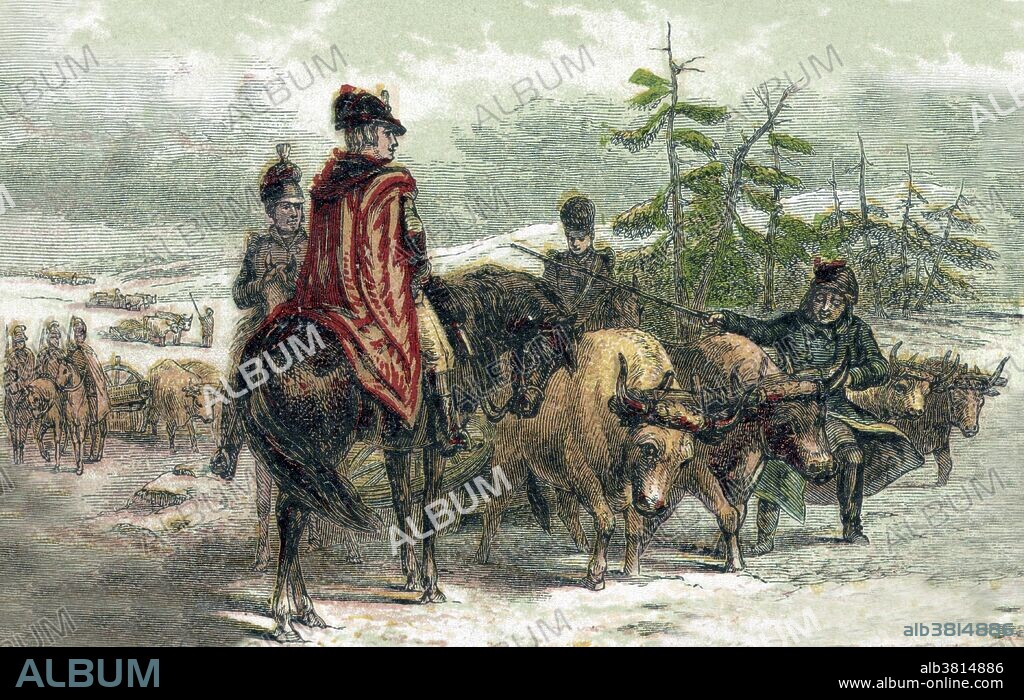alb3814886
Knox Expedition, Noble Train of Artillery, 1775

|
Add to another lightbox |
|
Add to another lightbox |



Buy this image.
Select the use:

Title:
Knox Expedition, Noble Train of Artillery, 1775
Caption:
Colonel Henry Knox with an oxen train delivering armaments to Cambridge during the Siege of Boston The Siege of Boston (April 19, 1775 - March 17, 1776) was the opening phase of the American Revolutionary War. New England militiamen prevented the movement by land of the British Army garrisoned in what was then the peninsular city of Boston, Massachusetts. Both sides had to deal with resource supply and personnel issues over the course of the siege. British resupply and reinforcement activities were limited to sea access. As the siege wore on, the idea arose that cannon recently captured at the fall of forts Ticonderoga and Crown Point in upstate New York could have a decisive impact on its outcome. Knox is generally credited with suggesting the prospect to Washington, who put him in charge of an expedition to retrieve them. Reaching Ticonderoga on December 5, Knox commenced what came to be known as the noble train of artillery, hauling by ox-drawn sled 60 tons of cannon and other armaments across some 300 miles of ice-covered rivers and snow-draped Berkshire Mountains to the Boston siege camps After eleven months of the siege, the British abandoned Boston by sailing to Nova Scotia.
Category:
ILLUSTRATION • History: United States
Credit:
Album / LOC/Science Source
Releases:
Image size:
4650 x 2938 px | 39.1 MB
Print size:
39.4 x 24.9 cm | 15.5 x 9.8 in (300 dpi)
Keywords:
1770S • 1775 • 18TH CENTURY • 18TH CENTURY, THE • 18TH CENTURY. • 18TH • AMERICA • AMERICAN REVOLUTION • AMERICAN WAR OF INDEPENDENCE • AMERICAN • ARMAMENTS • ARMES • ARMS • ART • ARTILLERY • ARTWORK • BERKSHIRES • CANNON • CELEBRITIES • CELEBRITY • CONTINENTAL ARMY • DRAWING • EVENT • EVENTS • FAMOUS PEOPLE • FAMOUS • FIGURE • GOVERNMENT • HENRY KNOX • HISTORIC • HISTORICAL • HISTORY • HISTORY: UNITED STATES • ILLUSTRATION • ILLUSTRATIONS • ILUSTRATION • IMPORTANT • KNOX EXPEDITION • MALE • MAN • MEN • MILITARY • NOBLE TRAIN OF ARTILLERY • NOTABLE • OXEN TRAIN • PEOPLE • PERSON • PERSONALITIES • PERSONALITY • POLITICAL • POLITICS • REVOLUTIONARY WAR • SIEGE OF BOSTON • SNOW • SOLDIERS • TRANSPORT • TRANSPORTING • UNITED STATES • US • USA • WAR OF INDEPENDENCE • WEAPON • WEAPONRY • WEAPONS • WELL-KNOWN • WINTER • XVIII CENTURY
 Pinterest
Pinterest Twitter
Twitter Facebook
Facebook Copy link
Copy link Email
Email
